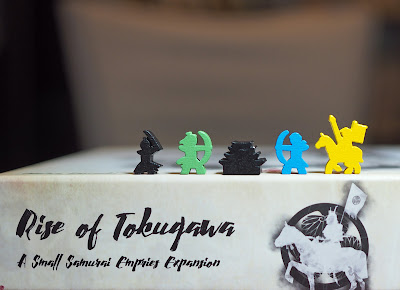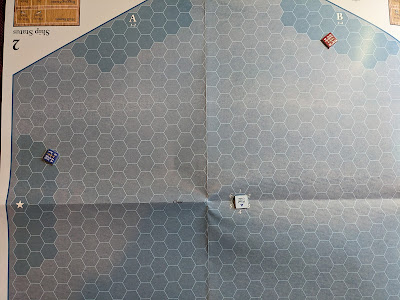New house stuff beckoned today, although not much. A trip to Bunnings for some bits and pieces, and then a morning spent putting up a mirror and shelf in the bathroom. Naturally I rewarded myself with an afternoon playing games.
One of the kickstarters I got recently is the expansion for Small Samurai Empires. This has all kinds of goodies in it. The biggest thing is an extra mapboard and all the necessary expansions required for adding a fifth player. Probably not that relevant for me, as moving beyond a two-player game has proved hard enough. However it also includes some extras for all player levels.
You get new unit types, shown here with the black tokens for the fifth player (House Tokugawa). Archers allow you to negate enemy castles, whilst generals are a powerful unit that trigger a powerful game effect when recruited onto the board. You gain these new units by upgrading your basic samurai tokens. The rules also allow for elite samurai as well. This set of changes look quite fun, but I think I need to get my regular opponents better acquainted with the basic game first.
A big selling point for me, though, is the addition of a solitaire mode. This adds a special board for placing the order on, as well as a set of tokens for determining where the programmed rivals act during a turn.
In the solo mode you the one of the houses and face House Mori and House Takeda (Yellow and Blue) as rivals for the control of Japan. Naturally for this game I tied out the new House Tokugawa black pieces.
As a player you start out with a couple of pieces in each region. The opposing pieces will pop up according to what location and order tokens the non-player houses draw.
Enemies can appear in any region, but the system carefully weights them towards the ones where most points can be scored. This is the position early in the first era - rival armies are appearing across the board.
I was lucky in this game; my rivals steered clear of the potentially valuable orange region (Central Honshu), allowing me to establish a strong presence there.
Once there I kept up a steady pressure on the rival houses, fighting off any incursions until I have the level of control needed to win the game.
So far I've played three games of this so far (they play fairly quickly, despite having to understand the sometimes poorly-worded rules), losing the first one, winning the second (photographed above) by a huge margin and winning the third thanks only to a lucky card-draw at the end which gave me just enough points to edge ahead of blue.
The solo mode is good fun, and a great way to practice the game's basic mechanisms.
Having become supreme ruler of Japan a couple of times, I switched to 'Under The Southern Cross'. I want to play one of the multi-ship scenarios at some stage, but with limited time I decided to try out one of the single-ship actions. In fact I went for one of the first, an 1817 encounter between a a Uruguyan privateer, the Atrev de Sol and a Portuguese ship, the Gaviota Mar.
The duel rules use a special mapboard which actually has a lot of the charts and tables on it as well, and also area to put the ship status and damage counter, which is very handy.
Here's the ships in their starting positions; the Uruguayan vessel is dark-blue and the Portuguese ship maroon. Both ships are equal in combat strength, but the Portuguese have a slight edge in quality.
The duel mode uses the standard game rules, but things can be modified by the use of special manuever cards to help add interest and a degree of unpredictability to such a small game. These cards can actually be used in the main game, but I imagine they add a fair bit of complexity to something that's already fiddly enough.
Both ships have a hand of cards, and play one each at the start of the turn. The chosen card dictates initiative, but also includes modifiers to firing and manuever rolls, as well as limiting what moves a ship can make. So choosing your card is a tricky decision. Each card also has an event on it; you can play events at any point during your turn (or your opponent's) as required, so again you sometimes have to choose between using a card for its initiative effect or holding on to it for the bonus it may give you later.
The two ships approach. The Uruguayan Atrev de Sol had briefly given up the weather-gauge hoping to cut across the Portuguese ship's bow (the wind is coming from the top of the picture).
But it couldn't manage the turn, and he two ships passed each other, exchanging broadsides as they did so. The slight edge the Portuguese have counted here, and the Uruguayan came off slightly worse.
The two ships circled round to engage again, but the Gaviota Mar got in a lucky long-range rake (even if you get the arc for a rake you have to test for it, and it's harder at longer ranges).
This was enough to push Atrev de Sol to damaged status. Both ships tacked, and the Uruguayan attempted a rake of their own. They failed to line it up, and only did superficial damage to their opponent.
The two ships closed again. The Uruguayan captain took a gamble; as the two ships passed he held his fire, hoping to swing onto the Portuguese vessels stern at close range and deliver a damaging broadside. The Portuguese ship, however, fired as he sped past, and rolled incredibly well, inflicting massive damage on the Atrev de Sol. And that was it. The Uruguayan got into the position he wanted to be in, but his ship was shattered as a fighting vessel, He struck his colours just as the vessel sank from under him.
The Portuguese ship was one decent shot of being damaged and only a couple of being vulnerable to striking, so the Uruguayan gamble was worth it.
Here's some of the cards in action. They won't make much sense if you don't know the game, but ... here they are.
Anyway, a good afternoon spent playing games. If I get time tomorrow I may have a go at a larger scenario for 'Under The Southern Cross'.














No comments:
Post a Comment